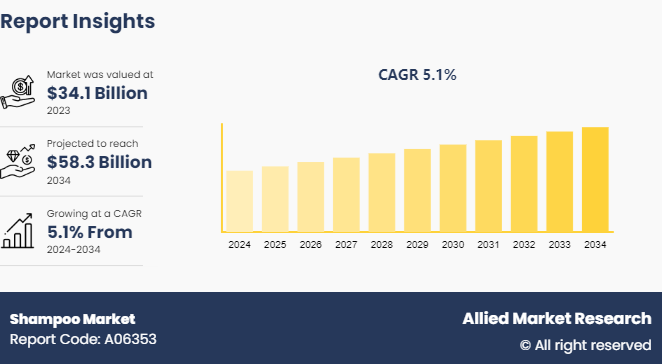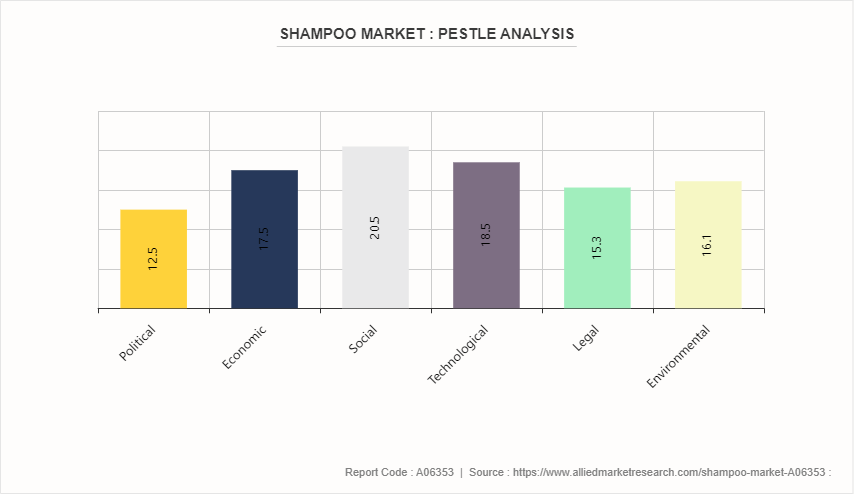Shampoo Market Research, 2034
The global shampoo market size was valued at $34.1 billion in 2023, and is projected to reach $58.3 billion by 2034, growing at a CAGR of 5.1% from 2024 to 2034. Shampoo is a hair care product designed to cleanse the scalp and hair by removing dirt, oil, and other impurities. It consists of a blend of surfactants, which are cleansing agents, along with conditioning agents, fragrances, and preservatives. The formulation of shampoo varies to cater to different hair types and concerns, such as dandruff, dryness, or oiliness.
Shampoos can also include additional ingredients such as vitamins, botanical extracts, and proteins to nourish and strengthen the hair. The product is usually applied to wet hair, massaged into the scalp to create a lather, and then rinsed out. Innovations in the shampoo market have led to the development of sulfate-free, organic, and customized options to meet diverse consumer preferences and needs.
Key Takeaways
The shampoo market study covers 20 countries. The research includes a segment analysis of each country in terms of value ($Billion) for the projected period 2024-2034.
More than 1, 500 product literatures, industry releases, annual reports, and other such documents of shampoo industry participants along with authentic industry journals, trade associations' releases, and government websites have been reviewed for generating high-value industry insights.
The study integrated high-quality data, professional opinions and analysis, and critical independent perspectives. The research approach is intended to provide a balanced view of global markets and to assist stakeholders in making educated decisions to achieve their most ambitious growth objectives.
Key Market Dynamics
The growth in demand for natural and organic products has significantly surged the shampoo market growth. Consumers are increasingly aware of the potential harmful effects of synthetic chemicals found in conventional shampoos, which has led them to seek alternatives made from natural ingredients. The shift is driven by a broader trend toward wellness and sustainability, as consumers prioritize products that are both safe for personal use and environmentally friendly. Brands have responded by expanding their product lines to include shampoos that boast organic certifications and eco-friendly packaging.
In addition, the rise of social media and digital marketing has strengthened consumer awareness and preference for clean beauty products, further driving the demand for natural and organic shampoos. As a result, the shampoo market share has experienced rapid growth, with companies innovating to meet consumer expectations for transparency and ethical sourcing.
However, concerns over harmful chemicals in conventional shampoos have restrained market demand by driving consumers toward alternative products. Ingredients such as sulfates, parabens, and phthalates, commonly found in traditional shampoos, have raised health and environmental concerns. These chemicals can cause scalp irritation, hair damage, and potential long-term health risks, prompting consumers to seek safer, more natural options. As awareness grows through social media and educational campaigns, consumers are becoming more discerning about product ingredients.
Moreover, the shift has pressured manufacturers to reformulate products or lose market share to brands offering chemical-free alternatives. Consequently, conventional shampoos face declining demand, pushing companies to adapt to changing consumer preferences.
Furthermore, the growing demand for customized and personalized products has created significant opportunities in the market. Consumers increasingly seek products tailored to their specific hair types, concerns, and preferences, such as formulations for curly hair, color-treated hair, or scalp sensitivity. The trend is driven by a desire for more effective and individualized hair care solutions. Brands such as Prose, Function of Beauty, and HairRx, have responded to this demand by offering customizable shampoos that allow consumers to select ingredients, fragrances, and packaging based on their unique needs. Thus, such personalized approach not only enhances consumer satisfaction but also promotes brand loyalty. As a result, companies that provide tailored products are gaining a competitive edge, encouraging innovation and diversification in the shampoo market.
PESTLE Analysis of Global Shampoo Market

Political: Regulatory policies concerning cosmetic ingredients and safety standards significantly influence the shampoo market. Government regulations on labeling and advertising impact product marketing and distribution strategies.
Economic: Economic factors such as consumer spending power and economic stability affect demand for shampoos. Economic downturns can lead to reduced spending on non-essential products, while growth periods may increase demand for premium brands.
Social: Increase in consumer awareness regarding health, wellness, and environmental sustainability drives demand for natural and organic shampoos. Social media and influencer marketing have a strong impact on consumer preferences and brand loyalty.
Technological: Technological advancements in product formulation and packaging innovations are crucial in the shampoo market. Research and development lead to the creation of new products that cater to specific hair concerns and consumer needs.
Legal: Compliance with international and local laws regarding product safety, advertising, and environmental impact is mandatory. Intellectual property rights and patents also play a role in maintaining competitive advantage.
Environmental: Growing awareness of environmental issues influences consumer preferences toward eco-friendly and sustainable products. Companies are adopting greener manufacturing processes and biodegradable packaging to meet consumer expectations.
Market Segmentation
The shampoo market segmentation is done on the basis of product type, price-point, end user, distribution channel, and region. On the basis of product type, the market is categorized into medicated and non-medicated. Based on price-point, the market is divided into low, medium, and high. As per end user, the market is classified into men, women, and kids. According to distribution channel, it is fragmented into supermarkets/hypermarkets, drug stores or pharmacy, mass merchandiser, departmental stores, mono-brand stores, specialty stores, and online sales channel. Region wise, the shampoo market is analyzed across North America, Europe, Asia-Pacific, and LAMEA.
Regional/Country Market Outlook
The growth of the shampoo market in the Asia-Pacific region is driven by factors such as increased consumer awareness about hair health, leading to higher demand for specialized shampoos addressing specific concerns such as dandruff and hair loss. Innovations in product formulations, including herbal and natural ingredients, attracted health-conscious consumers in the region. The influence of Korean and Japanese beauty trends, emphasizing unique hair care routines, also boosted interest in diverse shampoo offerings. Furthermore, effective marketing strategies and brand collaborations with local influencers strengthened brand visibility and consumer trust. The rise of online shopping platforms expanded access to a wide range of products, which has made it easier for consumers to explore and purchase different shampoos tailored to their needs. And the following trend is expected to create numerous opportunites for shampoo manufacturers during the shampoo market forecast period.
The shampoo industry in Europe has experienced strong growth potential owing to rise in consumer interest in sustainable and eco-friendly products. Demand for shampoos with natural and organic ingredients reflected a shift toward health-conscious purchasing decisions. The aging population contributed to a rise in demand for products targeting hair thinning and scalp health. Moreover, innovation in personalized hair care solutions, leveraging data and technology to offer tailored products, appealed to diverse consumer needs. Expansion of online retail channels facilitated easier access to niche and premium products, enhancing market reach. Furthermore, the growing awareness and emphasis on personal grooming and hygiene further supported the expansion of industry, as consumers sought high-quality and effective hair care solutions.
Industry Trends:
The clean beauty trend significantly influenced the shampoo market by driving demand for transparency and ethical sourcing. Consumers increasingly sought products with clear, understandable ingredient lists, leading brands to reformulate shampoos to eliminate harmful chemicals such as sulfates, parabens, and synthetic fragrances. The shift resulted in the rise of shampoos that emphasize natural and organic ingredients, catering to health-conscious buyers. In addition, cruelty-free and vegan certifications became crucial, as consumers prioritized animal welfare. Brands adapted by using sustainable packaging materials and adopting environmentally friendly practices. The clean beauty movement encouraged innovation in the shampoo market, pushing companies to create effective yet gentle products, ultimately reshaping consumer expectations and industry standards toward more conscious and responsible production.
The trend toward multi-functional products has set a trend in the shampoo market by meeting consumer demands for convenience and efficiency. Manufacturers developed shampoos that offered multiple benefits, such as combining cleansing with conditioning, color protection, or anti-dandruff properties. The innovation attracted busy consumers seeking to streamline their hair care routines without compromising on performance. The appeal of timesaving and space-efficient products boosted sales and brand loyalty, driving competition among brands to deliver more comprehensive solutions. In addition, the trend encouraged innovation in formulation technologies, leading to advanced products that effectively address diverse hair concerns. The growing popularity of multi-functional shampoos also impacted packaging designs, with brands emphasizing the versatility and unique benefits of their products on labels.
Competitive Landscape
The major players operating in the shampoo market include Estee Lauder Companies, Henkel AG &Co. KGaA, Hindustan Unilever Limited, Johnson & Johnson, Kao Group, L’Oreal S.A., Marico Limited, Natura & Co., Oriflame Holding AG and Procter & Gamble (P&G) .
Other players in the shampoo market include Reckitt Benckiser Group plc, Coty Inc., Unilever PLC, Shiseido Company, Limited, Amorepacific Corporation, Luxottica Group S.p.A., Avon Products, Inc., PZ Cussons plc, Mary Kay Inc., Belcorp, and so on.
Recent Key Strategies and Developments
In February 2024, Henkel launched a sulfate-free shampoo to cater to the demand for gentler hair care products to tap into the premium segment of the shampoo market?.
In April 2023, L'Oréal introduced a new anti-dandruff shampoo to address increasing hair loss issues linked to lifestyle changes and environmental factors.
In January 2023, Procter & Gamble expanded its product line with a new herbal shampoo, focusing on natural ingredients to appeal to environmentally conscious consumers.
In May 2022, Medimix, a brand under the AVA group, launched its total care shampoo, infused with natural ingredients aimed at catering to all hair types.
Key Benefits For Stakeholders
- This report provides a quantitative analysis of the market segments, current trends, estimations, and dynamics of the shampoo market analysis from 2024 to 2034 to identify the prevailing shampoo market opportunities.
- The market research is offered along with information related to key drivers, restraints, and opportunities.
- Porter's five forces analysis highlights the potency of buyers and suppliers to enable stakeholders make profit-oriented business decisions and strengthen their supplier-buyer network.
- In-depth analysis of the shampoo market segmentation assists to determine the prevailing market opportunities.
- Major countries in each region are mapped according to their revenue contribution to the global market.
- Market player positioning facilitates benchmarking and provides a clear understanding of the present position of the market players.
- The report includes the analysis of the regional as well as global shampoo market trends, key players, market segments, application areas, and market growth strategies.
Shampoo Market Report Highlights
| Aspects | Details |
| Market Size By 2034 | USD 58.3 Billion |
| Growth Rate | CAGR of 5.1% |
| Forecast period | 2024 - 2034 |
| Report Pages | 290 |
| By Product Type |
|
| By Price Point |
|
| By End User |
|
| By Distribution Channel |
|
| By Region |
|
| Key Market Players | Estee Lauder Companies Inc., Natura & Co., Hindustan Unilever Limited, L’Oreal S.A., Oriflame Holding AG, Procter & Gamble, Henkel AG &Co. KGaA, Kao Group, Johnson & Johnson, Marico Limited. |
The global shampoo market size was valued at $34.1 billion in 2023, and is projected to reach $58.3 billion by 2034, growing at a CAGR of 5.1% from 2024 to 2034.
The global shampoo market to grow at a CAGR of 5.1% from 2024 to 2034.
The major players operating in the shampoo market include Estee Lauder Companies, Henkel AG &Co. KGaA, Hindustan Unilever Limited, Johnson & Johnson, Kao Group, L’Oreal S.A., Marico Limited, Natura & Co., Oriflame Holding AG and Procter & Gamble (P&G).
By region, Asia-Pacific held the highest market share in terms of revenue in 2023.
The growth in demand for natural and organic products has significantly surged the shampoo market growth.
Loading Table Of Content...



